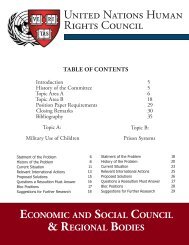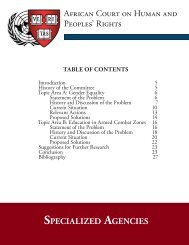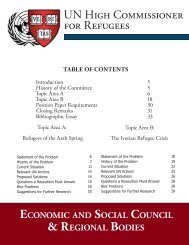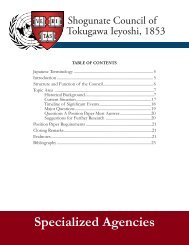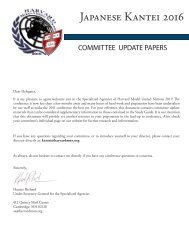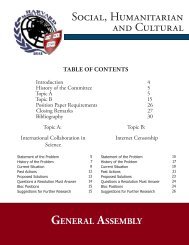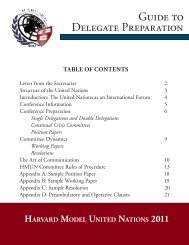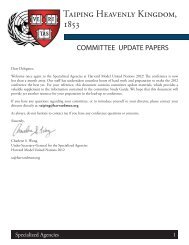World Trade Organization - Harvard Model United Nations
World Trade Organization - Harvard Model United Nations
World Trade Organization - Harvard Model United Nations
Create successful ePaper yourself
Turn your PDF publications into a flip-book with our unique Google optimized e-Paper software.
<strong>World</strong> <strong>Trade</strong> <strong>Organization</strong><br />
supply side (the country that exports the goods, which<br />
in these cases are the low-income countries). The studies<br />
recommended improvements in customs and export<br />
agencies and other trade-related institutions. 15<br />
When is Aid Effective? The Paris Declaration<br />
The Paris Declaration on Aid Effectiveness sets out<br />
the principles that nations should follow to maximize<br />
effectiveness of their aid. These include: 1) ownership<br />
– the donor country must respect the right and<br />
responsibility of the partner country to exercise authority<br />
over its own development policies and strategies; 2)<br />
alignment – donors will align their assistances as stated<br />
by the partner country’s own development agenda and<br />
will try to support the partner country’s own systems<br />
(regulatory, technological and others) rather than<br />
developing their own parallel system in the country; 3)<br />
mutual accountability – donors and partners must be<br />
committed to mutual accountability and transparency.<br />
Donors should provide transparent and timely<br />
information regarding their aid flows to the partner<br />
countries while partner countries must periodically assess<br />
the progress in the implementation of development<br />
strategies; 4) harmonization – donors and partner<br />
countries will establish common arrangements, simplify<br />
procedures for policy planning and implementation, and<br />
share information with each other (making it effective).<br />
These principles ensure that the partner countries take<br />
ownership of their own development strategies and that<br />
donor countries listen to and understand the specific<br />
needs of each partner country. Giving partner countries<br />
more say in how their reforms are undertaken will ensure<br />
greater success rate.<br />
Effectiveness of aid for trade<br />
Despite having clear principles that would<br />
theoretically maximize the effectiveness of aid for trade,<br />
it is hard to quantify the effects of aid for trade since there<br />
are no clear indicators of aid for trade’s direct effect on<br />
economic growth. Some donor countries use indicators<br />
like the increase in trade volume and “adoption and<br />
implementation of trade policies that positively impact<br />
the poor” that are often meaningless because the effects<br />
of those policies often cannot be achieved or measured<br />
within the donor aid for trade program’s life cycle. These<br />
indicators are further influenced by other factors such<br />
as other donor aid, domestic producers improving trade<br />
performance through private investments, and domestic<br />
government policies that help the poor. Thus, it is often<br />
hard to trace the growth of trade and the economy<br />
directly to a specific donor’s aid program. 16<br />
Measuring effectiveness is complicated by the fact<br />
that it is difficult to measure the positive outcomes<br />
of these trade-related assistances. For some countries,<br />
simply changing the government’s mindset about why<br />
export-related infrastructure is important (when other<br />
alternatives like subsidies can quickly spur production<br />
and economic growth) can be a significant achievement.<br />
For others, changing approach to trade-related assistance<br />
such as focusing on revising tax and regulatory systems<br />
can also be an achievement. 17<br />
Current Situation<br />
South America<br />
South America has experienced tremendous growth<br />
within the past decade, driven mostly by a boom in<br />
prices for the region’s commodities. Countries in South<br />
America were early in following trade liberalization<br />
recommendations by the GATT and WTO and<br />
many have already formed regional trade pacts such<br />
as the Andean Community (CAN) and MERCOSUR<br />
economic blocs. These economic blocs have facilitated<br />
regional cooperation in trade, promoted exports in<br />
various countries, and led to the creation of trade-related<br />
institutions in most of the countries. All these factors<br />
have led to an average of 20% increase in exports between<br />
2001 and 2005. 18<br />
South American countries’ main trade challenges<br />
include the large number of trade negotiations going<br />
on at same time. Due to the fast pace and large number<br />
of negotiation meetings, policymakers do not have<br />
enough time to properly analyze options and seek the<br />
most optimal solutions. The focus on forming trade<br />
agreements also takes attention away from government<br />
support for research & development and improvements<br />
in regulation for product standards. 19<br />
Another important issue to be resolved is the lack<br />
of cohesion between different trade support institutions<br />
(TSI) throughout the region. The various national, local,<br />
sectoral, and technical TSIs often have insufficient<br />
coordination and duplicate functions among themselves.<br />
As a result, the TSIs can’t optimize the use of their<br />
resources in helping governments develop regulation in<br />
such areas as branding, certification, supply chains, and<br />
design. 20<br />
8<br />
Specialized General Assembly Agencies





